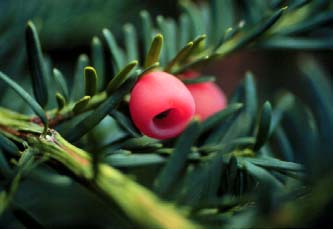Contents:
Common Names | Parts Usually Used | Plant(s) & Culture | Where Found
Uses | Warning | Bibliography
Scientific Names

- Taxus canadensis Marsh.
- Yew family
Common Name
- American Yew
Parts Usually Used
Leaves (needles)
Back to Top
Description of Plant(s) and Culture
Straggling evergreen shrub, rarely over 7 feet. Twigs smooth, green; reddish brown on older branches. Needles 2-ranked,
Back to Top
Where Found
Rich woods. Newfoundland to West Virginia; northeastern Kentucky to Iowa.
Back to Top
Uses
Compounds in this shrub have been found to be effective in the treatment of breast cancer.
Native Americans used minute amounts of toxic leaf tea internally and externally, for rheumatism, bowel ailments, fevers, colds, scurvy, to expel afterbirth, dispel clots, diuretic; twigs used as fumigant in steam baths for rheumatism. Leaves (needles) said to be antirheumatic and hypotensive. Yew sap was used by Celts to produce poison arrows. A component of the plant is under investigation for anticancer activity. The long bow was made of the wood of the yew.
Back to Top
Warning
All plant parts (except perhaps the red aril) of this and other yews contain the toxic alkaloid taxine and are considered poisonous. Ingesting as few as 50 leaves (needles) has resulted in fatalities. Berries are considered poisonous to man and beast.
Back to Top
Bibliography
![]() The Herb Book
The Herb Book, by John Lust, Bantam Books, 666 Fifth Avenue, New York, NY. copyright 1974.
![]() The Herbalist Almanac
The Herbalist Almanac, by Clarence Meyer, Meyerbooks, publisher, PO Box 427, Glenwood, Illinois 60425, copyright 1988, fifth printing, 1994
![]() Indian Uses of Native Plants
Indian Uses of Native Plants, by Edith Van Allen Murphey, Meyerbooks, publisher, PO Box 427, Glenwood, Illinois 60425, copyright 1958, print 1990
![]() Eastern/Central Medicinal Plants
Eastern/Central Medicinal Plants, by Steven Foster and James A. Duke., Houghton Mifflin Company, 215 Park Avenue South, New York, NY 10000
Herbal Gardening, compiled by The Robison York State Herb Garden, Cornell Plantations, Matthaei Botanical Gardens of the University of Michigan, University of California Botanical Garden, Berkeley., Pantheon Books, Knopf Publishing Group, New York, 1994, first edition
 How Indians Use Wild Plants for Food, Medicine & Crafts
How Indians Use Wild Plants for Food, Medicine & Crafts, by Frances Densmore, Dover Publications, Inc., 180 Varick Street, New York, NY 10014, first printed by the United States Government Printing Office, Washington, in 1928, this Dover edition 1974
![]() Webster’s New World Dictionary
Webster’s New World Dictionary, Third College Edition, Victoria Neufeldt, Editor in Chief, New World Dictionaries: A Division of Simon & Schuster, Inc., 15 Columbus Circle, New York, NY 10023
 The Magic of Herbs in Daily Living
The Magic of Herbs in Daily Living, by Richard Lucas, Parker Publishing Co. (1988).
